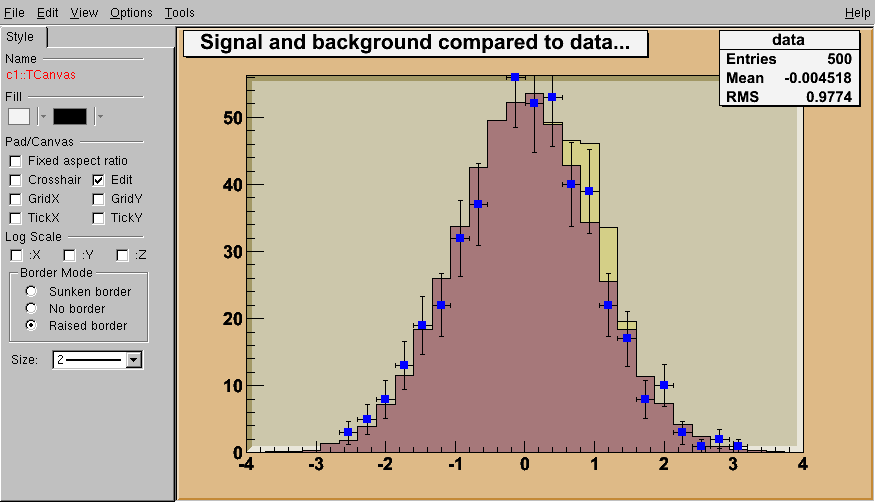#include <iostream>
#include "TH1.h"
#include "THStack.h"
#include "TCanvas.h"
#include "TFrame.h"
#include "TRandom2.h"
#include "TSystem.h"
#include "TVector.h"
#include "TObjArray.h"
#include "TLimit.h"
#include "TLimitDataSource.h"
#include "TConfidenceLevel.h"
using std::cout;
using std::endl;
void limit() {
TCanvas *c1 = new TCanvas("c1","Dynamic Filling Example",200,10,700,500);
c1->SetFillColor(42);
TH1D* background = new TH1D("background","The expected background",30,-4,4);
TH1D* signal = new TH1D("signal","the expected signal",30,-4,4);
TH1D* data = new TH1D("data","some fake data points",30,-4,4);
background->SetFillColor(48);
signal->SetFillColor(41);
data->SetMarkerStyle(21);
data->SetMarkerColor(kBlue);
background->Sumw2();
signal->Sumw2();
TRandom2 r;
Float_t bg,sig,dt;
for (Int_t i = 0; i < 25000; i++) {
bg = r.Gaus(0,1);
sig = r.Gaus(1,.2);
background->Fill(bg,0.02);
signal->Fill(sig,0.001);
}
for (Int_t i = 0; i < 500; i++) {
dt = r.Gaus(0,1);
data->Fill(dt);
}
THStack *hs = new THStack("hs","Signal and background compared to data...");
hs->Add(background);
hs->Add(signal);
hs->Draw("hist");
data->Draw("PE1,Same");
c1->Modified();
c1->Update();
c1->GetFrame()->SetFillColor(21);
c1->GetFrame()->SetBorderSize(6);
c1->GetFrame()->SetBorderMode(-1);
c1->Modified();
c1->Update();
gSystem->ProcessEvents();
cout << "Computing limits... " << endl;
TLimitDataSource* mydatasource = new TLimitDataSource(signal,background,data);
TConfidenceLevel *myconfidence = TLimit::ComputeLimit(mydatasource,50000);
cout << "CLs : " << myconfidence->CLs() << endl;
cout << "CLsb : " << myconfidence->CLsb() << endl;
cout << "CLb : " << myconfidence->CLb() << endl;
cout << "< CLs > : " << myconfidence->GetExpectedCLs_b() << endl;
cout << "< CLsb > : " << myconfidence->GetExpectedCLsb_b() << endl;
cout << "< CLb > : " << myconfidence->GetExpectedCLb_b() << endl;
cout << endl << "Computing limits with stat systematics... " << endl;
TConfidenceLevel *mystatconfidence = TLimit::ComputeLimit(mydatasource,50000,true);
cout << "CLs : " << mystatconfidence->CLs() << endl;
cout << "CLsb : " << mystatconfidence->CLsb() << endl;
cout << "CLb : " << mystatconfidence->CLb() << endl;
cout << "< CLs > : " << mystatconfidence->GetExpectedCLs_b() << endl;
cout << "< CLsb > : " << mystatconfidence->GetExpectedCLsb_b() << endl;
cout << "< CLb > : " << mystatconfidence->GetExpectedCLb_b() << endl;
cout << endl << "Computing limits with systematics... " << endl;
TVectorD errorb(2);
TVectorD errors(2);
TObjArray* names = new TObjArray();
TObjString name1("bg uncertainty");
TObjString name2("sig uncertainty");
names->AddLast(&name1);
names->AddLast(&name2);
errorb[0]=0.05;
errorb[1]=0;
errors[0]=0;
errors[1]=0.01;
TLimitDataSource* mynewdatasource = new TLimitDataSource();
mynewdatasource->AddChannel(signal,background,data,&errors,&errorb,names);
TConfidenceLevel *mynewconfidence = TLimit::ComputeLimit(mynewdatasource,50000,true);
cout << "CLs : " << mynewconfidence->CLs() << endl;
cout << "CLsb : " << mynewconfidence->CLsb() << endl;
cout << "CLb : " << mynewconfidence->CLb() << endl;
cout << "< CLs > : " << mynewconfidence->GetExpectedCLs_b() << endl;
cout << "< CLsb > : " << mynewconfidence->GetExpectedCLsb_b() << endl;
cout << "< CLb > : " << mynewconfidence->GetExpectedCLb_b() << endl;
TCanvas *c2 = new TCanvas("c2");
myconfidence->Draw();
delete myconfidence;
delete mydatasource;
delete mystatconfidence;
delete mynewconfidence;
delete mynewdatasource;
}
|
|

